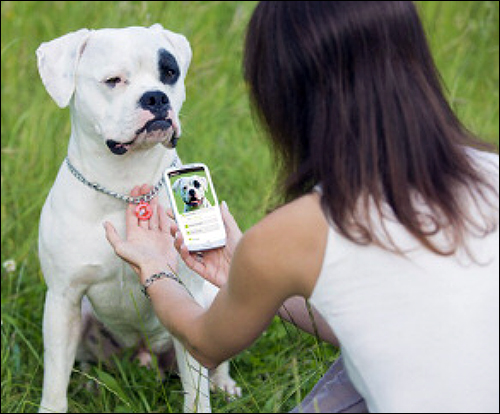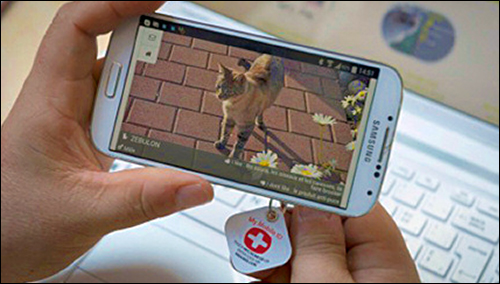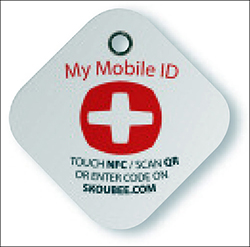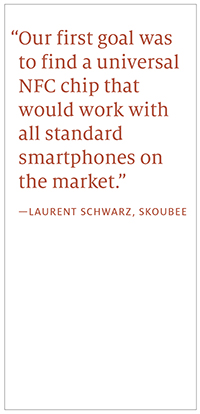Jun 24, 2015When a dog or cat runs off, his or her worried owner typically searches the neighborhood for the lost pet. If the pet isn't found immediately, the owner posts fliers with the animal's photo on utility poles and distributes them door to door, in hopes a stranger will find and return the beloved pet. The search can last days, weeks or months, during which time the pet may roam outside the neighborhood. But even if the lost animal remains within the dedicated search area, a stranger may not recognize and associate the stray with the photo on the sign.
Some dogs and cats have an embedded low-frequency RFID microchip that includes the animal's unique ID number, which is associated with the owner's information in a pet-recovery database. The tag is typically scanned only when a pet is turned into an animal shelter or a veterinarian's office.

Skoubee, a Swiss-based company, aims to make it easier to reunite lost pets with their owners. In October 2014, Skoubee introduced an ID medal that can be attached to a pet's collar. The medal has a Near-Field Communication (NFC) chip on the front, and a Quick Response (QR) code on the back. Both can be read with an NFC-enabled smartphone or other mobile device, so the finder can access the pet's public information on the Skoubee website and contact the owner. In addition, the tag has a printed eight-digit personal identification number (PIN) that can be entered on the website.
Most people don't have access to a low-frequency RFID reader to scan an implanted microchip, says Skoubee CEO Laurent Schwarz, but increasingly, people don't go anywhere without their smartphones.
Pet owners who enroll in the Skoubee program pay 30 euros ($33) for an ID tag. Then, they can create a public and private online profile for their pets. If a pet gets lost, the owner can log on to the pet's profile and access the "lost pet" function, which will send an alert to other Skoubee members that the pet is lost.
The private profile can be used to manage a pet's medical records, which pet owners can access with a smart device. It's a convenient way to keep track of vaccination schedules, veterinarian appointments and medication refills, Schwarz says. The company is developing a way to send alerts to remind pet owners about these dates, most likely using Short Message Service (SMS) text messaging, he says.
Universal NFC
Schwarz conceived the idea for Skoubee while working on a national public transportation project in Switzerland, in which NFC smartphones were used to scan electronic tickets. Previously, he worked for more than 12 years at RFID companies, including Smartrac, HID Global and Sokymat, and was also involved for many years in the microchip implant business for animal identification.
In addition to being an animal lover and cat owner, Schwarz recognized a growing trend in the pet industry. "Dog and cat owners are more concerned with the health, well-being and nutrition of their pets," he says. "There was an incredible opportunity for a company to build a platform with products to address pet owner concerns. I identified the business case for using mobile devices to access relevant pet information."
In March 2012, Schwarz formed a product-development team that included IT specialists, hardware and supply-chain experts (including his former boss at HID Global), and experts in digital marketing. The team didn't consider using any technology but RFID.
"Our first goal was to find a universal NFC chip that would work with all standard smartphones on the market," Schwarz says. The medal has an integrated NFC chip (ISO 14443) from NXP Semiconductors printed on the front and a personalized QR Code and PIN on the rear.
Then, working with SentiNode, a technology solutions provider in Poland, the team developed a software platform that allowed it to program the chip with customized information.
The company also evaluated a number of firms to mass-produce a high-quality finished product. Tatwah Smartech was the only manufacturer capable of programming the tag, engraving the QR code on each product and producing the tags in large quantities, Schwarz says. Today, Skoubee has a fully automated line producing the medals at a Tatwah factory in China, he adds.
Skoubee developed a number of trial products to find the right form factor for the NFC tag. The tag had to withstand the force and stress it would likely undergo when attached to pet collars, Schwarz says. The team tested the various tags on different-size dogs and cats.
"The medal has a metal rivet and two additional small metal rings to increase the mechanical strength of the product on the pet's collar," Schwarz says. The medal weighs 4.2 grams (.15 ounces) and is 28 millimeters wide (1.1 inches) and 1.2 millimeters (.05 inches) thick. It is designed to operate in a temperature range of -20 degrees Celsius (-4 degrees Fahrenheit) to 65 degrees Celsius (149 degrees Fahrenheit).
Once the company designed a final product, it tested the medal with the NFC smartphones that were then on the market and determined it could achieve a standard reading distance of 7 centimeters (roughly 3 inches) maximum.
Skoubee also reached out to the pet community to get feedback on product features and pricing that would appeal to the market. It sent questionnaires, conducted interviews and made presentations to vets, breeders, pet owners and groomers.
Tagging Dogs and Cats
After 24 months of product development, Skoubee introduced the solution to pet owners in Switzerland. As part of its marketing effort, the company posted two videos on its website that show consumers how to use the product.

More than 500 medals were sold in one day shortly after the launch, Schwarz says, and to date nearly 4,500 medals are in use in the European market, including Switzerland, Italy, France, the United Kingdom, Germany, Belgium, Portugal, Norway and Holland. Skoubee foresees business in other European countries as well as in Japan and Brazil, he adds. The company plans to enter markets in the United States and Canada in 2016.
Skoubee recently began to promote the medal through Animalia, a pet insurance company in Switzerland. New Animalia members get discounts on Skoubee medals. This year, Skoubee also plans to market the product at Swiss pet stores.
The solution has a couple of potential shortcomings. Owners need to make sure their pets always wear their collars, even in the house or backyard, Schwarz says. Also, the tag provides minimal instructions—"touch NFC/Scan QR or enter code on Skoubee.com"—so someone who finds a lost animal might not know how to access the pet's information. To address this, Skoubee plans to educate the public about the product through television ads in the countries where it's available.
Photos: Skoubee


